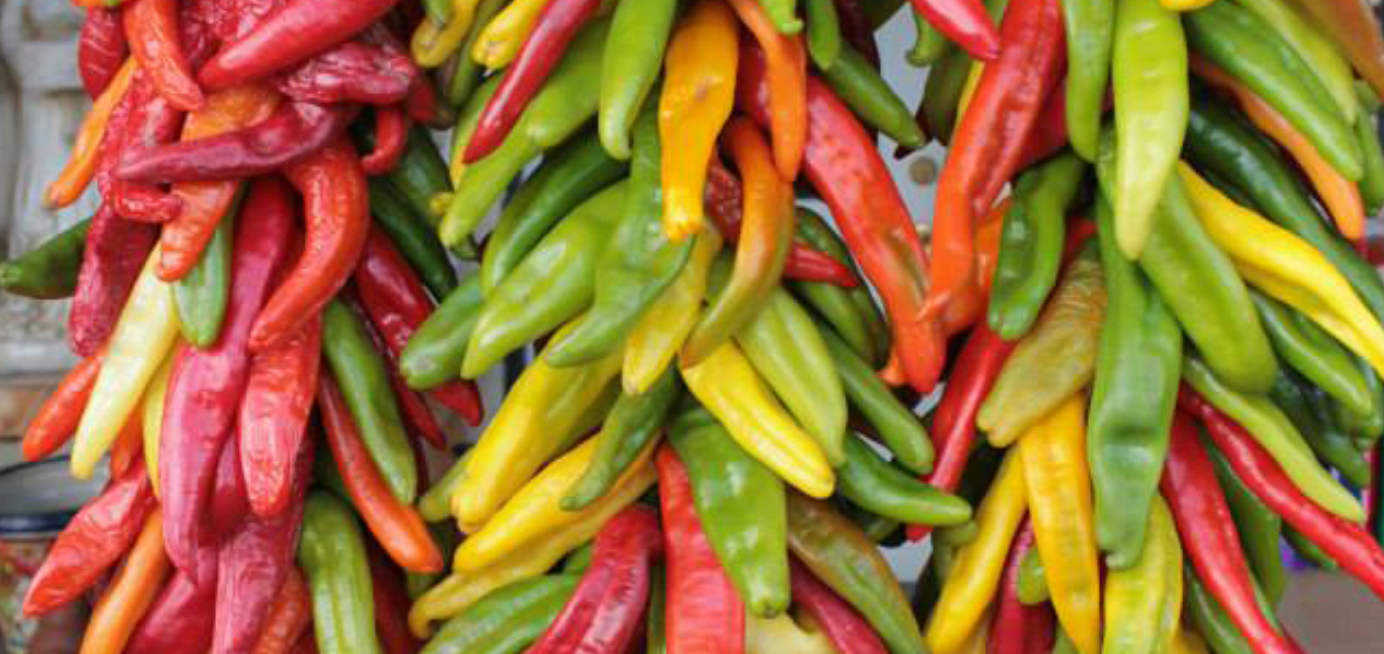
By Melissa Kruse-Peeples, NS/S Conservation Program Manager.
Whether it is red or green in New Mexico, spicy jalapeños of Tex-mex recipes, or fiery chiltepines of the borderlands, chiles are synonymous with Southwestern cuisine and central to our culinary identity.
Chiles are also a large part of the agricultural economy of our region. The hot summer climate and sandy soils of southern New Mexico and Arizona come together to create a million dollar chile industry. However, you may be surprised to learn that chiles are a relatively recent part of the 4,000 year old Southwestern agricultural history and were not commonly grown or eaten until the last several hundred years.

Most of the world’s domesticated chiles (Capsicum annum) are descendants from chiltepines (Capsicum annuum var. glabriusculum), tiny hot, firey round fruits that crow on bushy plants. Recently, a team of scientists, including NS/S co-founder Gary Nabhan, published results supporting the case that the domestication of chile from chiltepines occurred in central-east Mexico. The timing of the process of selecting wild chiltepines and creating new varieties of domesticated chiles is less certain but likely began as long ago as 7,000 years ago. The domestication has resulted in thousands of different varieties of C. annum chiles of different shapes, colors, and heat levels – from bell peppers to Chile de árbol to Poblanos. At Native Seeds/SEARCH, over 60 accessions of domesticated C. annuum chiles and 34 accessions of chiltepines are conserved within our seed bank. Other chile species including Capsicum frutescens, which includes Tabasco, and Capsicum chinense, which includes habaneros, were domesticated farther south in Central and South America.
Chile was a dietary staple in for millennia in what is now Mexico and Latin America along with corn, beans, squash, and amaranth. Spanish documents indicate that Maya and Aztec people ate chile with nearly every meal. But what is really interesting is that these other crops spread and became significant economic resources in the Southwest beginning around 2000 B.C. But not the chile. In fact, there is only a single example of a cultivated chile (Capsicum annuum) seed recovered from a pre-Spanish archaeological assemblage in the American Southwest/Mexican Northwest. Archaeologists Paul Minnis and Michael Whalen recently reported the presence of a domesticated chile seed from their excavations of a village near the major settlement of Paquime, also called Casas Grandes, dating to A.D. 1160-1205. However, by the Spanish Colonial period in the 1600s domesticated chiles are very common.
Wild chiltepines are native to southern part of Arizona, New Mexico, Texas, and Northern Mexico but they were not domesticated locally. The ancient region’s inhabitants did use the plant as a spice or even for medicinal reasons. But the rarity of seeds or phytoliths in archaeological contexts compared to regions farther south likely indicates chile was not commonly consumed, even in it’s wild form. The reason chiles are rare in likely because the diets of Southwestern peoples were relatively bland. There is other evidence that some ancient peoples in the region preferred bland food based on the aversions to other “spicy” foods such as wild mustards. However, chile and wild chiltepines eventually did become a standard ingredient in Southwestern dishes over the last several hundred years. Ethnographic information indicate that wild chiltepin harvesting trips were important social and economic ventures by Tohono O’odham, Pima, Yaqui, and Apache peoples in the region.
The popularity of domesticated chiles and domesticated chiltepines continues to rise. In fact, I bet it is hard to find a table in Southern Arizona – Indigenous, Hispanic, or Anglo – that doesn’t have a jar of chiltepines or hot sauce on it. Or at least that is how it should be. Similarly, every garden within our region should not be without a chile or chiltepin plant.
Negra Pasilla Dried Chiles
Chiles are relatively easy to grow, particularly because they can stand neglect and prefer poorer soils. Chiles seeds can be started inside as early as late December to get a head start on the spring season but they can be started as late as March or April. Chiles do need warm soil to germinate and direct sunlight to grow well. Protect forming fruit from too much direct, afternoon sun in the height of summer to avoid sunburn spots. Chiles are frost sensitive but with proper protection in the winter they will come back the following spring when temperatures rise. The semi-perennial nature is a trait from their wild ancestors.
Chiltepines are a little harder to start than domesticated chiles, but are easy to care for once established. Because chiltepines are a wild variety the wild conditions need to be mimicked. This means that the germination process should break down the seed coat which happens in nature inside the stomachs of birds. Unaffected by the capsicum chemicals that give chiles their spice, birds commonly eat the fruits. This process scarifies the seed enabling germination. Mimic this by soaking seeds with a drop of vinegar or rubbing gently on sandpaper. Mimic the growing conditions in the wild by providing well drained sandy soil and place underneath a mesquite or ironwood tree or place in an area that receives filtered sunlight.
Because of the huge diversity of chiles that are available, you are sure to find something that fits your palette perfectly. What not start you search for the perfect chile by visiting us online?

